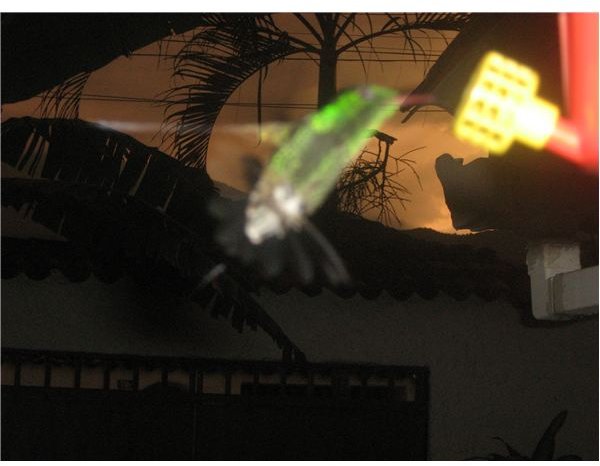Tips on How to Attract Hummingbirds & Take Great Pictures
Are There Hummingbirds Near You?
Look! Over above the flower blossoms – it’s a bee, it’s a bat, it’s a dragonfly?
No – it’s a hummingbird! The hovering winged wonders of nature. Seen any lately?
No matter where you may live, if there are hummingbirds in the area, then you can attract them and take eye-popping, salable digital photos. Depending on where you live from Spring through Autumn, and in some tropical locales year-round, you can use these simple but effective photography tips to get outstanding digital photos and videos of one of nature’s most spectacular winged creatures. First we’ll examine how to attract them to where you can photograph them. Then we’ll discuss setting up for photography of hummingbirds - they’re really fast you know! Next we’ll cover how to photograph them and when for best results. Finally, we’ll cover how to keep them coming back to your yard, patio or porch, year after year.
(Click on any image for a larger view)
How to Attract Hummingbirds
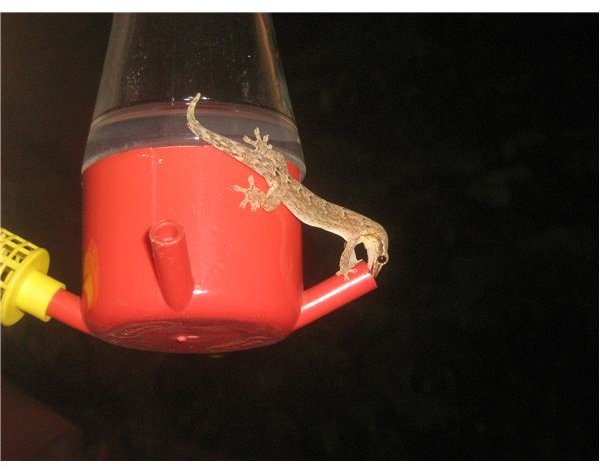
If there are hummingbirds in your area, you may need to attract them to where you can more easily photograph them. This often means setting up a hummingbird feeder. There are several functional models and styles from which you can choose. You may want to consider a hummingbird feeder model which has a guard over the feeding tube. This prevents other animals and insects such as bees, wasps, other types of birds and, in my area – small lizards (shown here), from poaching the hummingbird nectar and keeping the hummingbirds from feeding. Hummingbirds are very territorial and will fight off other hummingbirds from an area where they’re feeding unless there is an “ample supply” of food. This is usually accomplished by setting up several hummingbird feeders a few feet apart from one another.
Who says that it’s only hummingbirds that can hover? In this short hummingbird and wren video I filmed a wren who has learned to hover for the couple of seconds each that it needs to feed from a hummingbird feeder. It took a week or so for it to develop enough skill to do it. Now it’s a regular feeder. Sometimes the two bird types take turns or simply use different feeding tubes at the same time.
Setting Up the Hummingbird Feeder
Hummingbirds naturally feed on nectar of flowers and on occasion small insects. They will nest in areas of heavy shrubs protected from predators like cats, lizards, reptiles and larger birds. While there is a broad array of “special” hummingbird feed mixes available commercially, for years I’ve simply used a “_five or six tablespoons of sugar to a pint of boiled wate_r” solution with NO coloring of any kind added. It has always worked just fine and is really cheap to prepare. It’s important NOT to use honey, syrups or artificial sweeteners in hummingbird feed solutions as these can be potentially deadly. Hang the feeder near a window you can easily access and photograph from while inside. Another hummingbird feeder might be set up in full sunlight outdoors or in an area of open shade beneath a tree branch or large bush. You can work out whether you want different feeders set up in different locations for a variety of digital photo types. Remember that due to their high metabolic rate, hummingbirds feed at least every hour and quite frequently, several times an hour if they can easily do so. Hummingbirds feed by darting in and out, licking up the liquid feed by flicking their needle-thin tongue in and out.
Please continue on to page 2, where you will learn tips & tricks on how to take great pictures of hummingbirds, including recommendations on shutter speed and how to keep the hummingbirds coming back year after year.
Getting Pictures of Hummingbirds
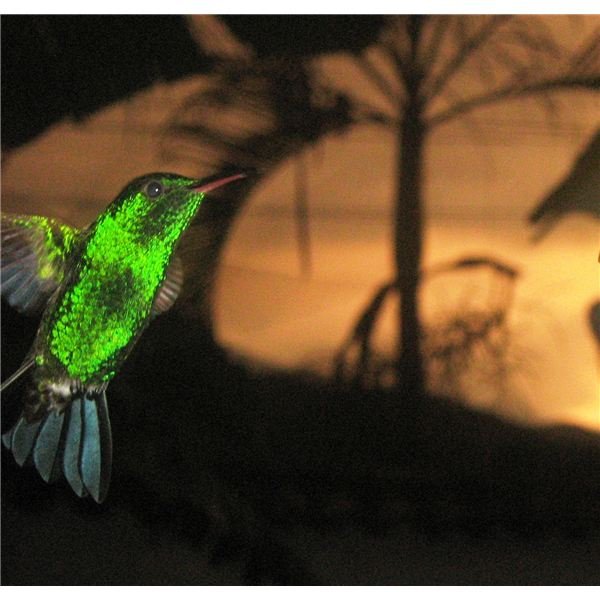
Since hummingbirds rest after dark, they feed most frequently and most heavily just before sunset and right after sunrise. You can use this to your advantage to photograph them. It gets dark around 6:30 pm year round here in Colombia because it’s so close to the equator. So I set up around 5:30 or so and start shooting by 6:00 pm or thereabouts. Although you can photograph them virtually anytime of the day when there’re around, they may tend to feed less frequently near your setup and may show up sporadically during many parts of the day. Flash is also useful to bring out the startling colors many of the scores of varieties of hummingbirds have like this “emerald-breasted” hummingbird (pictured). They adjust to “human presence” after a few weeks or so and will even enter an open window to reach a feeder set up just inside. Watch this video of a hummingbird feeding in “slow motion”.
Hummingbird Photography Techniques
When shooting digital photographs of hummingbirds in low light, a flash will bring out the colors of the bird’s feathers. A fill flash can also be effective during the day when photographing or filming in open shade. If you can set up a fast-firing strobe unit, even better, but initially the flash may disturb them. Use a fast shutter speed of 1/250th of a second minimum to 1/500th a second or 1/1000th of a second (or faster) to help “freeze” the birds in flight. Otherwise you get a colorful series of “blurs” as they unexpectedly change positions in flight. They can move so fast that they can appear as “ghosts” in your digital images. To help counter this “ghosting” effect, use a faster shutter speed if you can and wait to shoot when the bird “stops” in a holding position.
Get Up Close to Photograph Hummingbirds
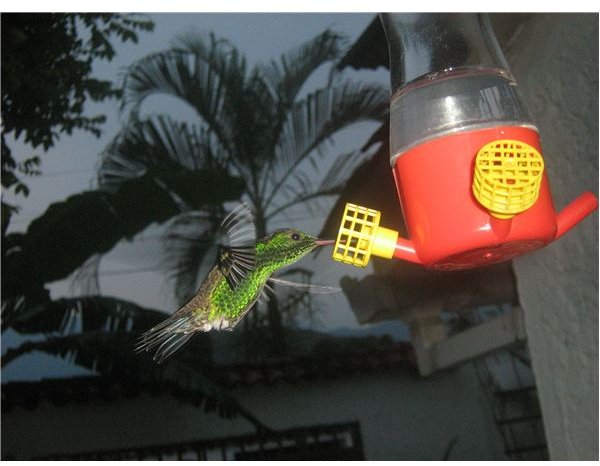
In getting close to the hummingbirds, you can use a telephoto lens or setup around 12-18 inches from the spot where they’ll be when you press the shutter. I prefer to get up physically close. My technique for the series of digital images and videos used in this article was to hang a Gorillapod flexible tripod on a window grating and mount the camera to that. I then draped a black towel behind and below the camera as a sort of “blind” to “hide” my presence. Using this setup I had only to reach my hand up to the camera shutter button and shoot when the hummingbird was in position in the camera viewfinder. I did nearly the same when filming the short videos, with the added benefit that you can always edit the final video clip. If you have a cable release or remote shutter mechanism setup, that’s all the better, especially if outdoors during the day.
How to Keep the Hummingbirds Coming Back
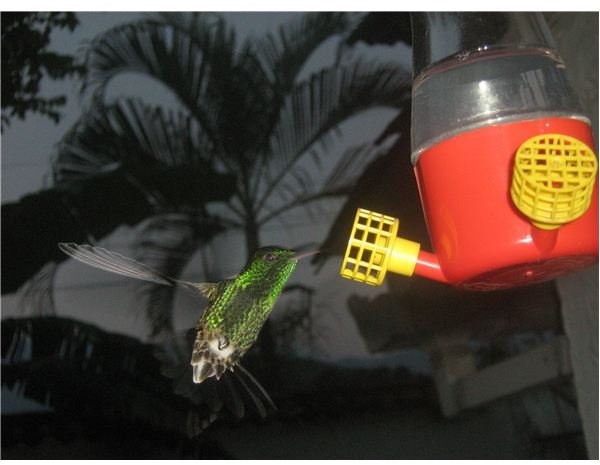
Before the weather starts to chill, most hummingbird species will migrate to warmer areas. They have regular migration patterns and routes but can learn to “deviate” from that route to come to your feeders. Keep them fed until they finally have migrated away from your area and be sure to have the feeders “setup” and “ready” when they return on the next migration and hummingbirds will keep coming back, year after year, to your patio, porch or yard.
Now you can attract them and take attention-getting, salable digital hummingbird photos. So how about giving it a go?
Hummingbird Videos and Other Resources
<strong>BBC Hummingbird video</strong>
Amazing Hummingbird videos (Quick time needed to view videos)
